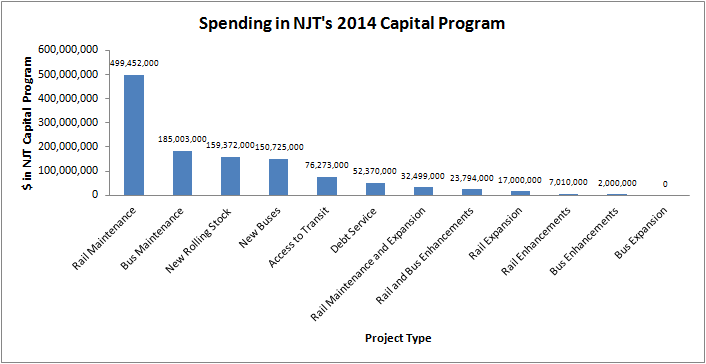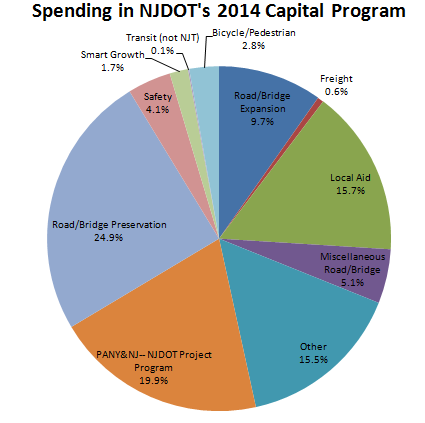 TSTC’s new analysis of the New Jersey Department of Transportation’s (NJDOT) and New Jersey Transit’s (NJT) Transportation Capital Program for fiscal year 2014 reveals encouraging shifts towards greater investment in bicycle, pedestrian and transit projects. However, the agency is still spending too much money to build new roads and bridges for short-term traffic congestion relief instead of redirecting more of these funds to maintain the State’s existing roads and bridges and retrofit more of the State’s most dangerous roads to be Complete Streets compliant.
TSTC’s new analysis of the New Jersey Department of Transportation’s (NJDOT) and New Jersey Transit’s (NJT) Transportation Capital Program for fiscal year 2014 reveals encouraging shifts towards greater investment in bicycle, pedestrian and transit projects. However, the agency is still spending too much money to build new roads and bridges for short-term traffic congestion relief instead of redirecting more of these funds to maintain the State’s existing roads and bridges and retrofit more of the State’s most dangerous roads to be Complete Streets compliant.
The analysis finds:
| Positive | Negative |
| The percentage of dollars going to projects that significantly expand New Jersey’s roadways and bridges has decreased by 16.5 percent. | The percentage of funds dedicated to expansion projects is still high. |
| The percentage of dollars going to projects that make the streets safer for pedestrians and bicyclists has increased by 34 percent. | The percentage of dollars going to projects that maintain the State’s roads and bridges has decreased by 16.2 percent. |
| The percentage of dollars going to NJT has increased by 5.5 percent. | A little over 30 percent of the NJT portion of the 2014 Capital Program will go towards funding for buses, yet in Fiscal Year 2012, bus trips made up almost 60 percent of NJT’s average weekday unlinked passenger trips. |

While the Capital Program has already been adopted for Fiscal Year 2014 (which began in July), moving forward, TSTC urges NJDOT and NJT to:
- Shift away from expansion projects as congestion relief and instead, focus on alternative modes to provide congestion relief
- Increase funds for fix-it-first to maintain and repair existing infrastructure
- Increase funding for bicycle and pedestrian projects
- Increase transparency in the Capital Program by identifying all project component costs including the cost of bicycle or pedestrian accommodations on road projects and identifying compliance/exemption to NJDOT’s Complete Streets policy
- Increase funding for bus capital and operations
And, because transportation is so important to New Jersey’s economy, the Campaign also calls on Governor Christie and the State Legislature to create and approve new, dedicated revenue sources to replenish the Transportation Trust Fund.
The full report can be found here.

If New Jersey Transit truly integrated bus and rail with no transfer penalty when taking more than one vehicle with a fare structure based on the current bus zones, would 60 percent of the rides still be on bus? If New Jersey Transit Rail were told to make intrastate service a priority with regular interval service on all lines such that there would be at least half-hourly service in rush hours to get between any two stations on a given line with no more than a 5 minute transfer what would that do to the modal split? People should be able to commute easily to Paterson, Elizabeth and New Brunswick by rail. The lines are there. New Jersey needs to make better use of its investment in rail.
[…] widen Route 4 in Teaneck, because “congestion related projects compete directly with limited fiscal resources that are available to address safety and to maintain the State’s aging […]
[…] to a Tri-State analysis from earlier this year, the New Jersey Department of Transportation’s (NJDOT) $3.98 […]
[…] New Jersey and New York fared better than the national average (20 percent for expansion in NJ, 23 percent in […]
[…] transit in the state, dedicates a lot less funding for road and bridge expansion projects than in previous years. But will this shift in priorities be […]
[…] projects comprise nearly 32 percent. By comparison, expansion projects made up 10 percent of the 2014 Capital Program funds and maintenance/preservation projects 25 percent; in 2013 expansion projects accounted for […]